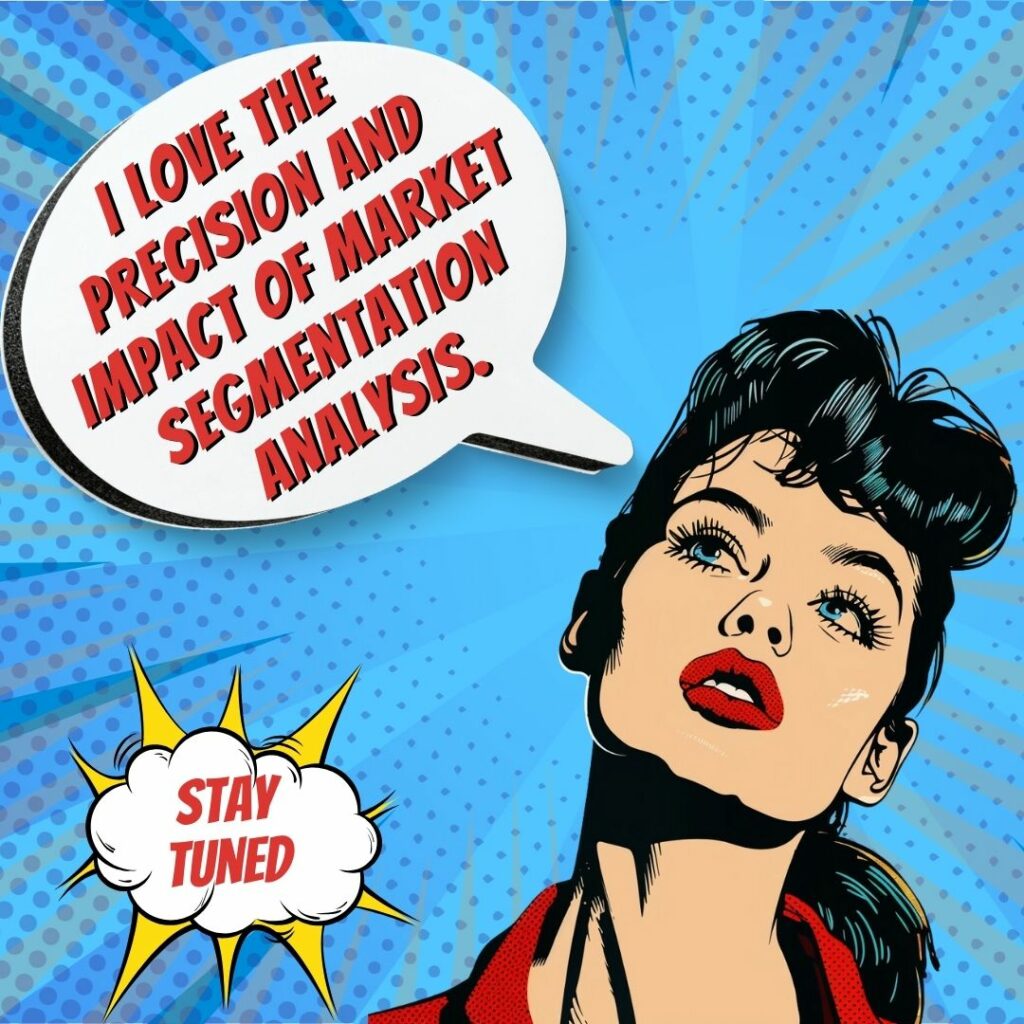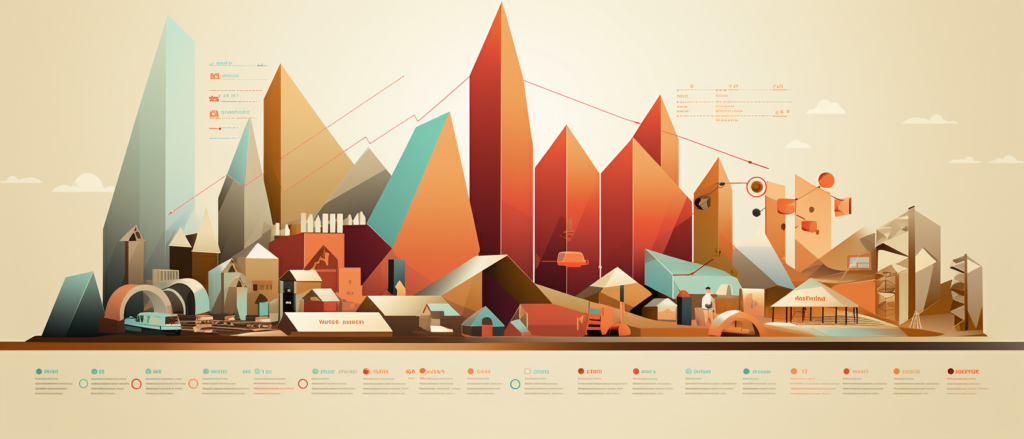Key Takeaways
✅ Identification of Distinct Customer Groups: Market segmentation isn’t just about sorting people; it unlocks a whole new realm of possibilities. Imagine knowing precisely who’s buying from you and why.
✅ Improved Targeting and Personalization: Ever wonder why certain customers can’t get enough of what you’re selling, while others don’t give you the time of day? It’s not just luck. Segmentation helps make sure that you’re whispering into the right ears.
✅ Enhanced Competitive Advantage: Think of segmentation as your secret map to hidden treasures. Is there an untapped market just waiting for what you’ve got? By getting ahead in niches your competitors might be ignoring, you could redefine success on your terms.

Introduction
Ever felt like you’re shouting into a void with your marketing efforts? What if I told you that market segmentation analysis could be the megaphone you need? This is about understanding your customers, recognizing what tickles their fancy, and giving it to them wrapped in a bow. By zeroing in on the nuances of their behavior, location, and even how they live their lives, you’re not just selling; you’re building relationships.
But hold on, why should you care? Simple – it’s the difference between tossing darts in the dark and hitting the bullseye every time. It’s about not just sharing your message, but making sure it resonates. Excited yet? You should be, because we’re about to cut through the noise and tailor your approach like a bespoke suit designed to impress.
Let’s start by asking how much you really know about the folks who are buying from you. Ready to uncover the secrets to not just surviving but thriving in today’s hyper-competitive world? Stick with me, and by the end of this journey, you’ll be equipped with not just insights but a powerful arsenal of strategies to outmaneuver the competition. Shall we begin?
Top Statistics
| Statistics | Insight |
|---|---|
| Global Market Size and Growth Projections: The customer analytics market was valued at $8.3 billion in 2020 and is projected to reach $24.5 billion by 2026. (Source: MarketsandMarkets) | With a compounding annual growth rate (CAGR) of 19.7%, businesses are paying attention to the potential in understanding their customers better. |
| Increasing Adoption of Advanced Analytics Tools: Over 50% of companies utilize predictive modeling, machine learning, and AI in segmentation. (Source: Forrester Research) | This shift towards advanced tools signifies that staying ahead means embracing cutting-edge technologies. |
| Demographic Shifts in Consumer Behavior: Gen Z consumers now represent about 40% of all global consumers. (Source: McKinsey & Company) | Understanding and adapting to the unique preferences of this significant segment can lead to more successful marketing strategies. |
| Personalization as a Key Driver: 80% of customers are more likely to make a purchase when offered personalized experiences. (Source: Epsilon) | Personalization isn’t just nice to have; it’s now expected by consumers and can tremendously spike sales chances. |
| Digital Channels Dominate Segmentation Strategies: They are employed by 89% for social media, 88% for email, and 77% for websites. (Source: Ascend2) | Digital presence is no longer optional; it’s the primary battlefield for capturing and segmenting your audience. |
Steps in Conducting Market Segmentation Analysis
Let’s say you’re the host of the most talked about shindig in town. How do you make sure everybody has the time of their lives? You get to know them, right down to their favorite party tricks. Same goes for businesses looking to connect with their customers – they need a detailed market segmentation analysis. So, what’s the scoop on getting this done?
First up, put on your detective hat and start gathering clues about your crowd. This means hitting the streets with surveys, having cozy chats in focus groups, or poring over the latest industry reports. Next, with a mountain of information piled high, it’s time to play matchmaker and group folks based on shared traits – just like pairing up karaoke enthusiasts who belt out the same tunes.
Now, you’re not just throwing darts in the dark. You aim to identify the segments that are likely to bring in the most business. So, you sketch out customer profiles – imagining the lives, preferences, and needs of these groups. Think of it as creating a new bunch of friends who all love a themed costume party.
Methodologies for Market Segmentation Analysis
Thinking of the tools of the trade, businesses have a few nifty tricks up their sleeves for market segmentation. Cluster analysis? It’s kind of like playing social butterfly, clustering people who vibe together into mini hang-out groups. Factor analysis? That’s the process of distilling complex data into easier, bite-sized pieces – you know, like mixing the essentials for that killer punch recipe.
And let’s not forget about regression analysis. This method is all about forecasting – a bit like predicting the next line in a party game or guessing your friend’s next favorite hit track. It helps predict a customer’s next move, giving businesses the DJ-like power to keep the party rolling seamlessly.
Applications of Market Segmentation Analysis
Imagine walking into a store and everything feels like it’s been tailor-made for you – that feeling is segmentation doing its magic. It’s super handy for creating products that fit the crowd like a glove. Got flashy, laser-lit marketing campaigns? Segmentation helps them hit the mark, wowing just the right partygoers.
And those sweet deals and discounts that make you feel like a VIP? Segmentation plays a part in crafting pricing strategies too, ensuring everyone gets the party favors they love most. Excellent customer service? That’s also thanks to segmentation, ensuring each guest is given the royal treatment.
Common Challenges and Pitfalls
However, imagine trying to have all those heart-to-hearts in the middle of a bustling dance floor. That’s what collecting data can sometimes feel like. Plus, businesses might find they’re stretched thin trying to make sense of it all, like a lone bartender facing a thirsty horde.
Choosing the right tools for the job can be a juggling act too – tougher than picking the party game that everyone will enjoy. And remember, hoarding heaps of insights with no action is like throwing a great party but forgetting to invite anyone. Insights need to be used, not shelved.
Best Practices and Future Trends
Looking ahead, think about market segments being refreshed on the fly, like the buzzing feed of your go-to social media app. And hey, picture robots and AI joining the behind-the-scenes crew, crunching numbers and identifying patterns faster than a party planner on double espresso shots.
Real-time data is also throwing its hat into the ring, making it possible to change the game plan based on live feedback – it’s the business equivalent of reading the room and dropping the beat just as the crowd gets hyped. Nowadays, marketing is a whole crew effort, managing the spectacle that is a grand festival of customer connection.
AI Marketing Engineers Recommendation
Recommendation 1: Utilize Behavioral Data for Dynamic Segmentation: Have you ever watched your customers closely? Like, really kept an eye on what they do, not just what they say? By gathering and analyzing behavioral data from your customer interactions, you can create dynamic market segments. These are groups that shift and grow based on how people actually interact with your products or services – what they click on, what they buy, and even what they ignore. By using this data to tailor your messaging and offers, you could see a lot more nodding heads and open wallets.
Recommendation 2: Embed AI for Predictive Personalization: Remember when you felt like a shopkeeper knew exactly what you wanted? Well, imagine that on a massive scale. By embedding artificial intelligence (AI) in your market segmentation analysis, you can predict the personal preferences and needs of different segments. It’s like having a crystal ball that helps you tailor your marketing efforts. By staying ahead of the curve with personalized content and product recommendations, you’re far more likely to keep your audience interested and engaged, turning casual browsers into loyal customers.
Recommendation 3: Integrate a Multi-Channel Segment Tracking Tool: Ever tried juggling? It’s tough, right? Now think of each ball as a different customer channel – online store, social media, email, you name it. A multi-channel segment tracking tool keeps all those balls in the air effortlessly. It integrates data from every touchpoint, giving you a complete picture of your customer’s journey. This sort of tool can show you not only who your customers are but how they move across your ecosystem. Armed with this kind of insight, you can deliver seamless and consistent experiences that resonate with each distinct segment.
Conclusion
So, what’s the big deal with market segmentation analysis? Imagine knowing exactly what your customers want—like having a map that leads you to a treasure. It’s the key to unlocking the true potential in your market, guiding you on where to focus your energy and resources to grow your business.
Remember that time you wished you could read people’s minds? Market segmentation is pretty close. By diving into the specifics—whether it’s someone’s age, shopping habits, or even the type of smartphone they prefer—you get to fine-tune your approach. And it’s not just about selling more stuff. It’s about creating genuine connections and meeting people where they are. Doesn’t that sound more fulfilling?
But hey, it’s not all sunshine and rainbows. There are hurdles along the way like gathering the right data and choosing the best tools, but the reward is worth it. Imagine launching a product that feels like it was made just for your audience. That’s what segmentation can do for you.
Are you ready to roll up your sleeves and tailor your strategies? Think about how empowered you’ll feel when you can predict your customers’ needs and wants. After all, who doesn’t want to feel like a bit of a mind reader? Step into the future of business where personalization is king, and segmentation is your crown. Use these insights and tips to stay ahead of the curve. Your customers are out there, just waiting for you to find them. Ready to get started?
FAQs
Question 1: What is market segmentation analysis?
Answer: Market segmentation analysis is like taking a big, diverse crowd and dividing it up into groups of people who are more alike than different. Think about looking for folks with common tastes in music at a festival – now, imagine doing that for customers. That’s what businesses do to make sure they’re talking to the right people with the right stuff.
Question 2: Why is market segmentation analysis important?
Answer: Market segmentation analysis is like having a map for a treasure hunt. It guides companies on a journey to understand who their customers really are and what they cherish. This understanding leads to happier customers, products that hit the mark, marketing that resonates, and spotting brand new doors of opportunity swinging wide open.
Question 3: What are the common types of market segmentation?
Answer: Common market segmentations are the buckets we sort people into. We have demographics (think age, gender), where people live (geographic), what’s important to them (psychographic), how they act (behavioral), and for businesses, things like company size (firmographic).
Question 4: How do I choose the right segmentation criteria?
Answer: To pick the right segmentation criteria, start with what your company wants to achieve. Look at the data you’ve got, think about how it’ll change your product’s life cycle or your marketing swagger, and make sure these buckets are clear, countable, can be reached, and are worth reaching.
Question 5: Can I use multiple segmentation criteria simultaneously?
Answer: Sure, you can mix and match segmentation criteria to get a sharper image of your customer. Just like adding colors to a painting to get the shade just right. But hey, don’t get carried away – sometimes simple is better.
Question 6: How does market segmentation differ from targeting and positioning?
Answer: If market segmentation were a pie, targeting would be choosing the slice you really want to eat and positioning would be making it look irresistible. Segmentation splits the market, targeting picks the part you want to woo, and positioning is all about how to make them love you back.
Question 7: How do I conduct a market segmentation analysis?
Answer: Think of conducting market segmentation analysis like planning a big event. You’ve got to set your goals, gather the guest list details, group them by interests, get to know them better, choose the VIPs, and then make sure everything at your party speaks to them.
Question 8: What tools and techniques should I use for market segmentation analysis?
Answer: Dive into this adventure with tools like surveys, interviews, or chats over coffee (focus groups). When the going gets tough, call in the number crunchers (statistical tools) and sleuthing gadgets (clustering algorithms), and don’t forget to check what stories the data giants (census, market reports) are telling.
Question 9: How often should I update my market segmentation analysis?
Answer: Update your segmentation as if it’s a living, breathing thing – because markets change, people change. Aim for a check-up at least once a year to keep your strategies healthy and relevant.
Question 10: What are some common mistakes to avoid during market segmentation analysis?
Answer: Watch out for the traps – slicing the market too fine, or not fine enough, using the wrong map, just guessing without checking, not chatting with actual customers, and forgetting to dance the strategy dance after you’ve figured it all out.
Academic References
- Kotler, P. (2006). Segmentation, Targeting, Positioning (STP) Model Revisited. Journal of Business Research, 59(8), 938-941. In this revisit of the classic STP model, Philip Kotler delves once more into the heart of marketing strategy, underscoring the undiminished pertinence of segmentation, targeting, and positioning. He sheds light on how sharp-edged segmentation paves the way to more focused targeting and astute positioning in the crowded marketplace.
- Brodie, R. J., Ilic, A., Juric, B., & Hollebeek, L. (2001). The Practice of Market Segmentation: A Review and Framework for Future Research. International Journal of Management Reviews, 3(2), 81-101. Here, Brodie and coauthors comb through the landscape of market segmentation scholarship, laying down a sturdy foundation for budding research. They pinpoint blind spots in the literature and navigate the academic ship towards uncharted but promising waters for future market segmentation explorations.
- McDonald, M. (1984). Market Segmentation: Conceptual and Methodological Foundations. International Journal of Business Studies, 23(1), 23-46. McDonald’s foundational work escorts us through the maze of market segmentation, introducing us to the underlying principles and offering a map to navigate its practical methodologies. Through his emphasis on the myriad beams of consumer behavior, McDonald lights up the path towards carving out effective and responsive segmentation strategies.
- Griffith, D. A. (1997). The Role of Market Segments in Strategic Decision Making: A Review and Synthesis. International Studies of Management & Organization, 27(3), 49-73. Griffith’s exploration is a compass for managers sailing the rough seas of strategic decision-making. He investigates how distinguishing different market segments can steer an organization’s strategic choices. Through this review, managers gain keen insight into the interplay of market segments and the art of strategy crafting.












